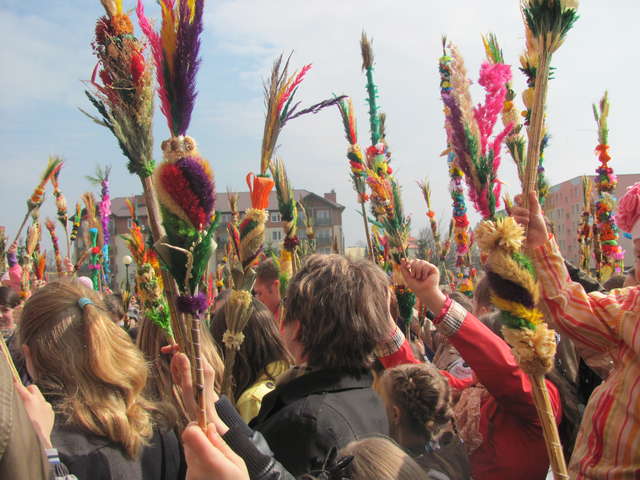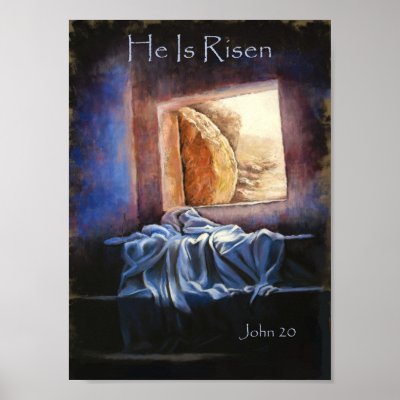It's interesting to me that Webster's lists third the sense we tend to use in everyday speech. However, I'm thinking of the first and second definitions in my following description of Holy Week.
Holy Week is the name given to the week from Palm Sunday to Easter Sunday. I will describe Holy Week as it's experienced by most Catholics. The minor details may differ from parish to parish, but Holy Week is essentially the same everywhere.
Palm Sunday
Before mass the congregation gathers outside the church. We hold palm branches (in America) or colored bunches of dried grasses and flowers (in Poland). After a series of prayers the priest blesses the palms.
This year the priest (or a deacon in America) reads from Luke 19:28-40, which describes Jesus entering Jerusalem on a colt. This event happened just days before Jesus was crucified. It was at this time that the crowds shouted, "Blessed is the King who comes in the name of the Lord! Peace in heaven and glory in the highest!"
At our parish here in Poland we then walk in procession around the church once, singing hymns, before entering the church. As I write this, the forecast for Sunday is for sub-freezing temperatures. I guess it's going to be a chilly procession!
A Palm Sunday procession in Poland
During mass on Palm Sunday, the Gospel reading is the Passion of our Lord. This year it is from Luke 22:14-23:56. Typically in American parishes this text is read by three readers. Most of it is read by a narrator, often a deacon. All of the parts spoken by Jesus are read by the priest. The third "reader" is the congregation. We, the congregation, read the parts of the crowd at Jesus' trial and crucifixion. Specifically, it is the congregation that speaks the parts shouted out by the crowd, "Away with him! Give us Barabas!" and "Crucify him! Crucify him!"
During every mass, the congregation stands during the reading of the Gospel. This is to show reverence for the very words of Jesus Christ that are read from the Gospel. Therefore, we are all standing during this reading of the Passion. But then, at the point where Jesus dies on the cross and the narrator reads, "With these words he breathed his last," everybody kneels and there is a short silent pause in the reading. At this moment you could hear a pin drop. On occasion I've heard quiet sobbing.
Then we all stand again until the end of the Gospel reading.
Like most Catholics, I'm unable to attend mass daily due to my work schedule, but the week progresses with these readings at mass: Monday, John 12:1-11, where Mary (sister of Martha, not Jesus' mother) annoints Jesus' feet with nard, a costly ointment, and wipes his feet with her hair. This signifies preparation for Jesus' burial. Tuesday, John 13:21-33, 36-38, where at the Last Supper Jesus foretells his betrayal. Wednesday, Matthew 26:14-25, where Judas agrees to betray Jesus to the chief priests for thirty pieces of silver while the other disciples make preparations for the passover meal.
Holy Thursday
And then begins the Easter Triduum, the three days from the evening of Holy Thursday to Easter Sunday. Holy Thursday is also known as Maundy Thursday. The word maundy comes from Old French mandé, meaning something commanded; from Latin mandatum, meaning commandment; from the words of Jesus, "Mandātum novum dō vōbīs: A new commandment give I unto you, love one another as I have loved you." (John 13:34).
Holy Thursday commemorates the Last Supper when, before eating, Jesus washed the feet of the apostles (John 13:1-15). At mass on Holy Thursday evening it is customary for the priest(s) to wash the feet of 12 of the parishoners, who have signed up for this beforehand.
The most moving part of the Holy Thursday mass for me is at the end. Here I need to explain that when the bread and wine are consecrated by a priest, the bread and wine become the actual body, blood, soul and divinity of Jesus Christ (John chapter 6, Matthew 26:26-28, Mark 14:22,24, Luke 22:19-20, 1 Corinthians 11:24-25, 27-30). At the end of the mass on this evening the priest places the consecrated hosts, the Blessed Sacrament - Jesus' very body - in something called a ciborium. The priest puts on a white humeral veil, picks up the ciburium and, flanked by two alter servers holding candles, follows a deacon or lay minister holding a cross in a procession through the church. The ancient Latin hymn Pange, lingua (Sing, my tongue) is typically sung.
As the Blessed Sacrament passes by, those in the congregation kneel in reverence. The congregation then follows the procession out of the church. The Blessed Sacrament is kept in a place of repose outside of the sanctuary all night. In our parish in Keller people were asked to sign up to spend at least one hour during this night praying and reflecting in this place with the Blessed Sacrament. This is done in memory of when Jesus prayed in the Garden of Gethsemane after the Last Supper, the night before he was crucified. "So you could not keep watch with me for one hour?" (Matthew 26:40)
After this mass the altar is stripped bare and the crosses are either removed from the church or veiled.
Good Friday
Technically speaking, mass is not celebrated on Good Friday. There is a Celebration of the Passion of the Lord. All masses begin with a hymn, but this Good Friday service begins in silence. The altar is bare without a cross and without candles. As on Palm Sunday, the Gospel reading this day is the Passion of the Lord. This year the reading will be John 18:1-19:42. Again, the congregation reads out the parts of the crowd which include, "Crucify him! Crucify him!" After the words, "Jesus . . . said 'It is accomplished'; and bowing his head he gave up the spirit," everybody kneels in silence for a short time.
Again the heavy ache in my chest. He died for our sins. The nails driven into his precious body were our sins. All our lying and selfishness and hatred and envy and abuse and pride pierced the flesh of Him who is perfect Love.
Later comes the Adoration of the Holy Cross. A large wooden cross is carried up the center aisle to the front of the church and all individuals in the congregation approach it, genuflect and/or kiss the cross. After Holy Communion is distributed and the priest's blessing given, everybody leaves the church in silence.
The churches remain empty and silent from now until Easter Vigil.
Holy Saturday
God is dead. So proclaimed the philospher Friedrich Nietzsche. I once heard somebody make the case that the modern developed world today is living a virtual Holy Saturday. For all practical purposes, God is dead as far we are concerned. Though a majority of us will report to pollsters that we believe in God, we live as atheists. We don't live our lives as though God actually exists for us. He doesn't guide our actions. He's not in our day to day thoughts. Maybe if a family member is stricken with cancer, we might remember and turn to Him.
Easter Vigil
As Jews have traditionally marked the beginning and end of days, sunset is the beginning of the following day. The Catholic Church has retained this custom in her liturgy.
After sunset on Saturday we celebrate the Easter Vigil. A blazing fire is prepared outside the church. The people gather with candles and from this fire their candles are lit. Then we process into the church.
During the Easter Vigil there are nine scripture readings - 7 from the Old Testament and 2 from the New (an Epistle and the Gospel). Some parishes reduce the number of Old Testament readings, but at least 3 of these must be read. The Old Testament readings outline salvation history up to the time of the Incarnation, the appearance of God among men as Jesus.
The readings this year are: Genesis 1:1-2:2, the creation account; Genesis 22:1-18, Abraham is tested by being commanded to sacrifice his only son Isaac. Isaac is spared, but later God will not spare is own Son, Jesus; Exodus 14:15-15:1, Moses leads the Israelites through the Red Sea; Isaiah 54:5-14, God promises to take his wayward people back; Isaiah 55:1-11, God pleads for his people to return to him; Baruch 3:9-15, 32-4:4, God again pleads to his people to return to him; Ezekial 36:16-28, God promises to gather his scattered people back together and cleanse them; Romans 6:3-11, concerning our dying with Christ in our baptism and Luke 24:1-12, the Resurrection of Jesus.
Up until the reading of the Epistle from the New Testament, the candles at the altar remain unlit. Then the candles are lit and we sing the Gloria (Glory to God in the highest . . .). I remember in one parish in Texas the lights were kept dim all during the Old Testament readings. Then, just before the reading of the Epistle from the New Testament, along with the lighting of the candles the lights were turned up to full brightness. This is to show that before the Incarnation people understood God more dimly, but Christ brought full light with his arrival.
It's a long mass, especially in America when new converts to Catholicism are received into the Church. But it's utterly beautiful and one of the highlights of my year. 7 years ago this Easter Vigil, I was received into the Catholic Church.
Easter Sunday







No comments:
Post a Comment